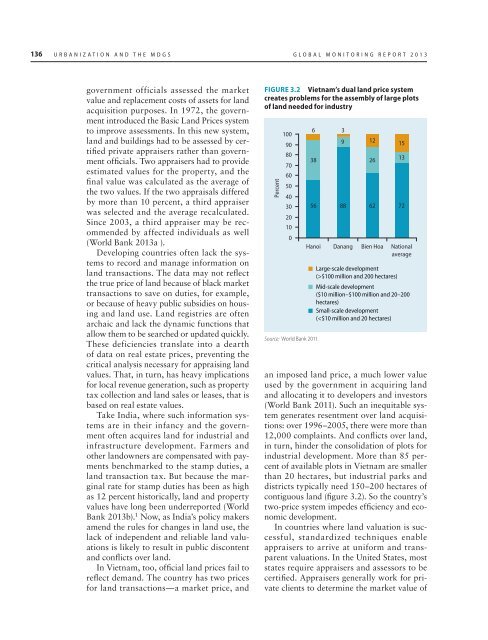rural-urban dynamics_report.pdf - Khazar University
rural-urban dynamics_report.pdf - Khazar University
rural-urban dynamics_report.pdf - Khazar University
Create successful ePaper yourself
Turn your PDF publications into a flip-book with our unique Google optimized e-Paper software.
136 URBANIZATION AND THE MDGS GLOBAL MONITORING REPORT 2013<br />
government officials assessed the market<br />
value and replacement costs of assets for land<br />
acquisition purposes. In 1972, the government<br />
introduced the Basic Land Prices system<br />
to improve assessments. In this new system,<br />
land and buildings had to be assessed by certified<br />
private appraisers rather than government<br />
officials. Two appraisers had to provide<br />
estimated values for the property, and the<br />
final value was calculated as the average of<br />
the two values. If the two appraisals differed<br />
by more than 10 percent, a third appraiser<br />
was selected and the average recalculated.<br />
Since 2003, a third appraiser may be recommended<br />
by affected individuals as well<br />
(World Bank 2013a ).<br />
Developing countries often lack the systems<br />
to record and manage information on<br />
land transactions. The data may not reflect<br />
the true price of land because of black market<br />
transactions to save on duties, for example,<br />
or because of heavy public subsidies on housing<br />
and land use. Land registries are often<br />
archaic and lack the dynamic functions that<br />
allow them to be searched or updated quickly.<br />
These deficiencies translate into a dearth<br />
of data on real estate prices, preventing the<br />
critical analysis necessary for appraising land<br />
values. That, in turn, has heavy implications<br />
for local revenue generation, such as property<br />
tax collection and land sales or leases, that is<br />
based on real estate values.<br />
Take India, where such information systems<br />
are in their infancy and the government<br />
often acquires land for industrial and<br />
infrastructure development. Farmers and<br />
other landowners are compensated with payments<br />
benchmarked to the stamp duties, a<br />
land transaction tax. But because the marginal<br />
rate for stamp duties has been as high<br />
as 12 percent historically, land and property<br />
values have long been under<strong>report</strong>ed (World<br />
Bank 2013b). 1 Now, as India’s policy makers<br />
amend the rules for changes in land use, the<br />
lack of independent and reliable land valuations<br />
is likely to result in public discontent<br />
and conflicts over land.<br />
In Vietnam, too, official land prices fail to<br />
reflect demand. The country has two prices<br />
for land transactions—a market price, and<br />
FIGURE 3.2 Vietnam’s dual land price system<br />
creates problems for the assembly of large plots<br />
of land needed for industry<br />
Percent<br />
100<br />
90<br />
80<br />
70<br />
60<br />
50<br />
40<br />
30<br />
20<br />
10<br />
0<br />
6<br />
38<br />
56<br />
Source: World Bank 2011.<br />
3<br />
9<br />
88<br />
Hanoi Danang Bien Hoa<br />
62 72<br />
Large-scale development<br />
(>$100 million and 200 hectares)<br />
Mid-scale development<br />
($10 million–$100 million and 20–200<br />
hectares)<br />
Small-scale development<br />
(

















